Read UKC Alpine Introduction Article, also by Rich Here
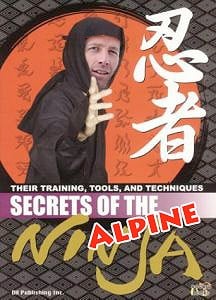
Brits who are technically very good on home ground can find it hard to adjust from our belt and braces approach, to the 'risk management' techniques necessary for speedy movement in the Alps. Slick and efficient alpinism usually comes from hard won experience, but there are some common sense tips and techniques that can help:
Read on for the 'Secrets of the Alpine Ninja'...
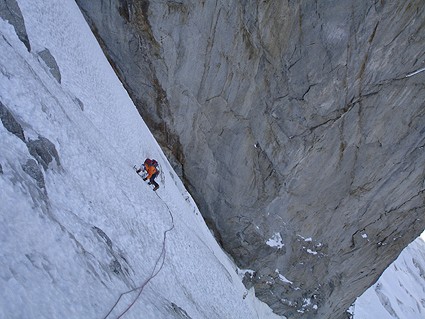
Preparation
Fitness: It goes without saying that good fitness is essential for efficient mountain travel. Training in the UK to make the most of your trip should focus on cardiovascular as well as specific climbing fitness. The closer your training can mirror your objectives the more effective it will be. Big mountain days, long fell runs, big scrambles, stacks of pitches –all good. Pounding a treadmill, pushing weights, stepmaster, skipping– not so good!
Knowledge is Power: Doing your homework is essential - gather as much information about your climb from as many different sources as possible. English guidebooks can often be outdated, as glacial activity and rock fall can alter the state of routes and approaches. Try local guidebooks, magazine articles, other climbers and local guides offices as useful sources of information. Nowadays the Internet has Alpine forums where people can post details about a route they've climbed, and pass on crucial bits of information. Armed with the confidence that you know your stuff, you can carry the correct gear, anticipate the line and conditions, and travel faster.
Look here for more info:
Plan Ahead: Think carefully about your logistics and have a clear-sighted plan for every outing. Include timings for each stage of the trip – approach, gearing up, climbing, descent and contingency. Guidebook times can be useful for planning, but remember that the times are for a fit and acclimatised party operating competently at that grade. If one of the elements is missing – acclimatisation, fitness or ability - you will be slower. Certain aspects of a climb such as the approach or descent, will be objectively dangerous at particular times of the day due to the heat of the sun. This factor will often dictate planned start/finish times more than the overall length of the outing.
Acclimatisation: Acclimatisation rates vary between individuals so its hard to lay down hard and fast rules, but staying well hydrated and building up gradually are the main principles. I find this works for the majority: Climb something up to approx 3300m, but sleep low (under 2800m) for the first couple of days. On the next outing climb higher and sleep between 3000m – 3300m for a night or two. Once comfortable sleeping at this altitude most people can handle 4000+m peaks. With prolonged exposure to altitude your performance will improve significantly- by mid season most guides can summit Mont Blanc without breaking a sweat!
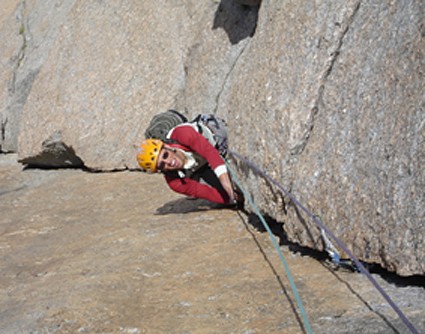
Equipment
Light is Right: After accessible beta, the next big aid to the modern climber is the abundance of lightweight gear on the market. In the Alps, light is usually right, allowing fast movement and also giving you the satisfaction that comes from a simple approach. Weight can be shaved from every part of your kit - from wire gate karabiners and high tech modern boots, to polystyrene helmets. One of the easiest savings to make is by having a light rucksack and waterproofs. Bearing in mind you will usually be climbing on a 'beau temps' forecast - leave the Scottish cardboard body armour at home. Shop around for modern lightweight fabrics such as Event and Goretex Paclite for good emergency protection.
Magic Plates: Think about time management down to the last detail. To this end, whilst climbing on pitched ground everything needs to be done whilst belaying, including eating, drinking and looking at the topo etc. Using a self-locking magic plate (eg Petzl Reverso) means you can belay a second but safely tackle your other jobs, utilising the dead time on the stance.
Ropes: Keep your rope-work simple – time spent handling ropes instead of climbing is time tagged onto the end of your day. On long alpine rock routes with a rap descent you need a traditional double rope system, to allow clean swift abseils. On long alpine routes that have a simple descent (over the top onto snow or small number of raps) consider climbing on a full weight rope and carrying a thin line such as 50m of 5.5mm dyneema. Handling a single rope is significantly faster and less exhausting to drag along, yet the second line allows full length abseils in case of retreat back down the line. Using this system requires a bit of practice and judgement but works well once you've got it sussed.
Protection: Especially on granite, carry a good rack of cams on long pitched routes, they are much faster to place and clean on smooth granite than nuts or hexes. Also keep a good look out for fixed runners and belays which can be used quickly, but remember to always check pegs and tat first.

Leashless Climbing: Being leash free on alpine ice/mixed terrain is a great time saver. Everything - from placing gear, to hands on rock moves (with tools over the shoulder) to stashing your tools at the belay – is easier without leashes and also adds to the enjoyment of the whole experience. The consequences of dropping a tool are a bit different to when icefall climbing, so it's wise to attach them to yourself using a lanyard system. These can be bought off the shelf, or made using 6mm cord and small accessory 'biners linking the tools to a simple chest harness/bandolier.
Looking after yourself: It's easy to forget about your basic needs whilst cruising along, until suddenly you're going at half pace and wondering why. An accessible supply of food and drink is essential. Personal taste dictates but moist cereal bars, fruit jellies or anything that's easy to munch in bite size packets, and doesn't melt in the sun! Have a stash in a chest pocket so you can take in a couple of hundred calories an hour as you cruise along. Similarly water should be accessible and taken slowly through the day – drinks bladders are great if you can keep them from getting tangled in your gear, but are mostly useless in winter. I use a simple insulated Nalgene bottle in the colder months, which keeps drinks from freezing but doesn't weigh anything.
Temperature Regulation: If you overheat you will dehydrate, and if you get cold you will loose morale. The extremes are heatstroke or hypothermia, but even moving slightly outside your optimum temperature can massively affect performance. A good maxim is to climb cool and belay warm – easily achieved by stripping the active layers down to the chilliest minimum and using super breathable fabrics, so you don't overheat when working hard. On long belays adding a belay jacket or windproof top will keep you toasty till you're ready to go again.
Technique
Technique! The single biggest aid to speediness is climbing ability. It makes sense that if you're climbing well within your limits you can move faster - so the bigger your comfort margin and the greater the range of routes you can motor up! So for all of us wanting to improve - training harder, trying harder and getting out more is a good first step!
Block Leads: On long pitched routes consider block leading, which involves one person leading 4 or 5 pitches in a row before the second takes over. In this way the climb can be broken down into a number of blocks, which can offer several advantages.
- The leader can get fully psyched for their block. The second can chill out and rest for an hour or more at a time.
- The leader can study and get mentally prepared for the next pitch above, which can help to speed up route finding.
- No one is sat on a belay ledge for too long, so in chilly weather you both stay warmer.
- If little gear is placed on a pitch the changeovers are very fast, as the second only has to pass back the gear used, rather than swapping the entire rack over.
Changeovers: Keep belay changeovers speedy and efficient. Three minutes saved on every belay will save an hour over 20 pitches, which could easily be the difference between beers in the valley or a night sitting on your rope! An efficient racking system really helps: bandoliers can be useful for passing quickdraws back and forth. Rope management is crucial and if leading in blocks the ropes often need to be re-stacked so the leader's ends come from the top of the pile again. With a little practice (and the help of a magic plate) you can start to re-stack the ropes once your second is 5-10m below you. Alternatively a lapped rope can be flicked upside down so the leaders ropes come from the top again, and off you go.
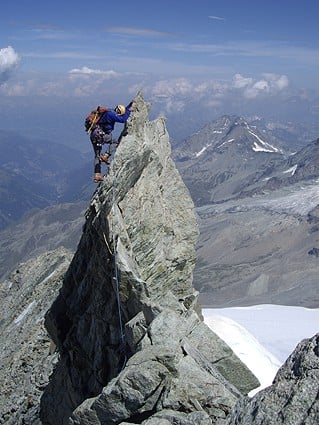
Moving Together: This is an essential Alpine skill. Your ability and confidence will dictate the standard of ground you are prepared to move together on, and the nature of the terrain will dictate the length of rope between each climber.
Key factors are:
- Knowing when it's appropriate for your team to move together, as opposed to pitched climbing.
- Being able to change techniques quickly and without tangles etc.
- Remembering that it's about compromise – moving together isn't always 110% safe, but it should be safer than soloing and faster than pitching.
Extra Tip: The ultimate moving together skill, 'simul-climbing' involves moving over technical ground that would normally be pitched. Prussic devices – most commonly the Wild Country Ropeman - are placed on runners above crux sections to hold the second should they fall - and prevent the leader being yanked off. Other runners are placed as sparingly as you can to conserve the rack and increase the distance you can travel before regrouping. This is an advanced technique requiring lots of practice to perfect, and should only be used once you have a good understanding of all the surrounding issues. Simul-climbing has resulted in some awesome speed climbing achievements well documented in the press and is a great skill to develop.
Route Finding: Adopt a common sense approach to route finding. Climbers in Britain are pampered with detailed route descriptions in most guidebooks. Alpine guides may have one small paragraph for a vertical kilometre of climbing, so the incentive lies with you to interpret it properly. Don't be afraid to look round the corner before committing yourself to an uncertainty - five minutes exploring can save hours of wasted time battling up the wrong line. Classic popular routes will normally be cleaned of loose rock, even if the rest of the hill is choss, so if you find yourself surrounded by rubble you are probably off route! Classic examples are the Matterhorn's Hornli Ridge and the Eiger North Face.
Footwork: Learn to climb rock quickly and efficiently wearing crampons. For Scottish mixed experts - no problem, but this is a real skill and takes time to master. On mixed routes you may encounter snow, ice, snow covered rock and dry rock in rapid succession and the only sensible option is to climb everything in crampons – taking them on and off regularly wastes valuable time.
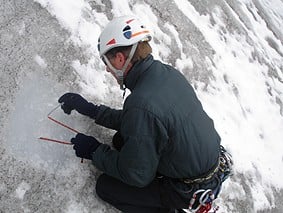
Crucial points include:
- Use a cows tail to clip into belay stations quickly.
- Use a French prussic as backup and for working on the rope (sorting tangles etc) whilst abbing.
- Keep communications simple. Some teams use a loud yodel or a whistle to mean 'rope free, come on down', as its easy to distinguish from other teams who may be on the mountain, and can be heard in nasty weather.
- Both team members should be active all the time eg. while one is pulling the ropes the other can be threading the next anchor. As soon as the knot arrives first man down can attach their abseil device while the remainder of the rope is pulled down. This kind of continuity is the key to speedy rapping.
Extra Tip: Always have some emergency abseil cord with you, 6mm static cord is ideal and if you have a couple of bandoliers in the team you already have a supply. I always carry a small stuff sack with a few meters plus an abolakov threader. Abolokovs (ice threads) are super useful even in summer, especially on hard glacial ice for descending tricky bergshrunds etc. They weigh nothing and increase your options if you need to make an emergency retreat.
And finally, practice your overtaking skills......and don't forget to have fun!
Alpine Guides are a friendly and experienced team of UIAGM guides led by Al Powell and Rich Cross – both well known enthusiasts in the UK mountaineering community. Alpine Guides offer a broad range of structured courses for every season including ski touring, ice climbing, rock climbing and Alpinism. These courses are complemented by a highly tailored private guiding service – for anything from bespoke training packages, to fun and flexible mountain holidays, to major north faces.
Rich is a UIAGM qualified mountain guide and co director of Alpine Guides Ltd. A well known figure on the UK mountaineering and winter climbing scene, Rich has climbed in Patagonia, Russia, Nepal, India, Pakistan, Canada, Alaska and throughout Europe. One of his finest mountaineering achievements to date is the first ascent of the NW ridge of Ama Dablam in Nepal with Jules Cartwright, for which he was a Piolet D'Or nominee in 2002. Rich is a passionate all rounder but especially loves his Scottish winter climbing - with some hard first ascents to his credit. When not climbing or guiding Rich lives in Sheffield where he enjoys his road biking, DIY and the odd night out clubbing.
Rich is sponsored by Rab and DMM.




Comments